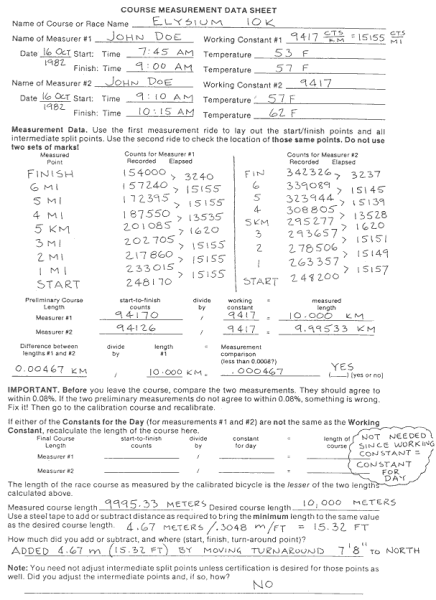
APPENDIX C - Example of Course Measurement
Measuring the Race Course
The race course has already been defined in terms of the route and desired start and finish points. The course is to be a 10-kilometer course. The start may be adjusted but the finish line is fixed.
You have completed your pre-measurement calibration rides and have determined your working constant to be 9417 counts per kilometer (15155 counts per mile). You have decided to lay out mile splits and splits for one and five kilometers (splits at every multiple of 5 km are recommended for all metric races and the half and full marathons).
You mark the finish line in the pavement on Turtle Road and note its location as 37 feet west of the "No Parking" sign by the Weed Shoe Store. You place the front axle of the bicycle over the Finish line and rotate the wheel forward until you reach an even thousands of counts (154000 counts). This simplifies the arithmetic but is not required. In your notebook, you record the initial count and calculate the count for each intended split, working backwards from the finish to the starting line.
These counter readings are calculated as follows. First you work out the metric splits:
Finish = 154000 counts
5 km 154000 + 5 x 9417 cnt/km = 201085 counts
1 km 154000 + 9 x 9417 cnt/km = 238753 counts
Start 154000 + 10 x 9417 cnt/km = 248170 counts
Knowing what the count will be at the starting line, you then work backwards to figure out what the count will be at each mile split:
Start = 248170 counts
1 mile 248170 - 15155 cnt/mi = 233015 counts
2 miles 233015 - 15155 cnt/mi = 217860 counts
3 miles 217860 - 15155 cnt/mi = 202705 counts
4 miles 202705 - 15155 cnt/mi = 187550 counts
5 miles 187550 - 15155 cnt/mi = 172395 counts
6 miles 172395 - 15155 cnt/mi = 157240 counts
After computing all these counts, you arrange them in a single list, in the same order as you will come to them in the measurement, from finish to start.
[Note: If these calculations for inserting mile splits into a metric course seem complicated, perhaps you can avoid them by laying out the course entirely with kilometer splits. An increasing number of races are moving to an all-metric format; e.g., see the Tulsa Run example in the next section on examples of course maps.]
You check the temperature and record the time and temperature. You mount the bicycle and ride, checking the count periodically. You make a sharp right-hand turn onto Fargo Road, staying close to the right-hand curb as you round the corner. Since the next turn will be a left, you sight a straight diagonal that will take you to the curb at the northeast corner of the intersection of Fargo and James Roads. Following this shortest course, you ride until you reach a count of 157240. You dismount and paint a short line and a small "6" on the pavement at the position of the front axle, indicating the tentative six-mile mark. You record the mark as located opposite the center of the driveway at 2180 Fargo Road.
You continue the diagonal path to the James Road intersection. At this point, you know that the next turn will also be a left turn. You find the corner to be gravelly and realize that runners could cut here. You note that a cone and monitor must be placed at this corner to keep the runners on the pavement. You measure following a path close to the curb on the north side of James Road. As you reach your count of 172395, you dismount and mark the tentative five-mile point.
Your next turn is left onto a winding bike path. You carefully follow the shortest route, crossing from one side of the path to the other as needed to follow the shortest route. You note and mark the four-mile, 5-kilometer, and three-mile marks.
Your next turn is a left onto River Street. As soon as you can see a straight path for the southwest corner of River Street and the bike path, you head for it. The next turn will be a right, heading north onto Joy Street. You sight the diagonal and ride the shortest route to the northeast corner of Joy and River Streets. You note and mark the two-mile mark.
Your tentative turn-around point on Joy Street is adjacent to a high-voltage tower. You head for the middle of the street adjacent to the tower. When you are opposite the tower, you stop and "freeze" the front wheel. You mark the turn-around with a line and a "T." You record the count. You then carefully reverse the direction of the bicycle while holding the front wheel frozen. You now sight for the northwest corner of Joy Street and Turtle Road where you will make a right turn, noting and marking the tentative one-mile and one-kilometer marks enroute.
You round the last corner and stay to the north side of Turtle Road. When the counter reaches 248170, you have reached your tentative starting line. You mark as before and paint a small "S" on the pavement next to the line. You then locate and record that the tentative starting line is 1.0 feet west of the telephone pole #3014-6C in front of Mergor Hardware Store at 2717 Turtle Road.
Now you are ready for the return measurement. This time, you've decided to ride from Start to Finish so you can make independent judgments of the shortest possible route. You hold the front axle of the bicycle over the tentative starting line that you marked in the first measurement, and rotate the wheel forward until the counter reads an even number of hundreds (248200). You mount and ride the course in the direction the race will be run. This time, you do not need to make any calculations before riding, and you do not make any new marks on the road. You simply stop at each of the marks you painted on the road during your first measurement (start, splits, turn-around, finish). At each such mark, you record exactly what your counter reads when the front axle is directly over the previously painted mark. You continue in this manner all the way to the (previously fixed) finish line.
Your count at the previously painted finish line is 342326. You calculate the start-to-finish counts for measurement #1 as 94170 and for measurement #2 as 94126. You divide each start-to-finish count by the working constant to obtain the preliminary course length for each measurement. You record these as 10,000 meters and 9,995.33 meters. Their difference is 4.67 meters. You then divide this difference by course length #1 (10,000 m) and note that the two measurements differ by 0.0467% which is within the 0.08% maximum allowable tolerance.
You now return to the calibration course and recalibrate the bicycle.
After recalibrating, you find that your post-measurement "finish" constant is smaller than your pre-measurement "working" constant, which means that your "constant for the day" (defined as the larger of the working constant or finish constant) is identical to the working constant. This allows you to avoid recalculating your measurements using the constant for the day. You need only adjust the race course for the difference between the lesser of the two measurement rides and the desired race distance.
The lesser of the two measured distances is 9,995.33 meters, based on ride #2. (Very likely, you did a better job of riding the shortest possible route during your second ride over the course; it is often easier to concentrate on riding the shortest route during the second ride because you don't have to worry about making new marks on the road this time.) This is the "official" measured length of the tentative course. To bring the course up to the full desired distance of ten kilometers, it must be lengthened by 4.67 meters.
At this point you must convert back to the Imperial system since you are (unfortunately) using a non-metric tape. You check Appendix E and note the conversion between meters and feet is 0.3048 meters = one foot. Dividing the 4.67 meters by 0.3048 meters per foot gives you 15.32 feet or 15 feet 4 inches, which is the distance by which you must lengthen your course to bring it up to the full 10 kilometers.
Rather than adjust the starting line, you opt to adjust the turn-around point. Using your steel tape, you measure 7 ft 8 inches north from your tentative turn-around point and make a permanent mark, using concrete nails pounded into the pavement. You also mark the turn-around with spray paint and a "T" for turn-around.
Since the difference between the marked intermediate split points and the split points that would result from using the lesser measurement value would not be greater than 5 meters (the overall adjustment was 4.67 meters), you opt to leave the intermediate split point marks where they are and mark them with concrete nails and spray paint.
You return to the start/finish area and make permanent marks for the start and finish lines.
You now return home and have lunch before sitting down to fill in the blanks in the forms for certification. You are satisfied with the morning's work.

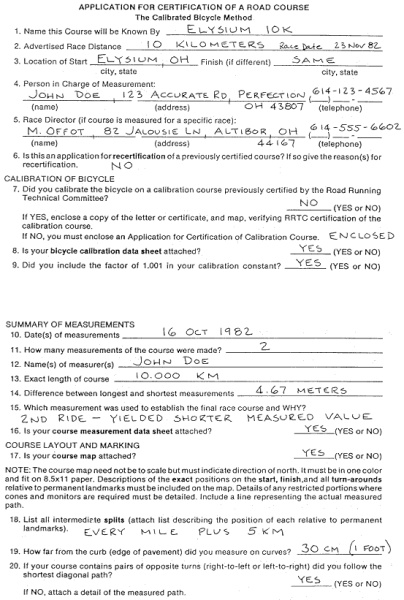
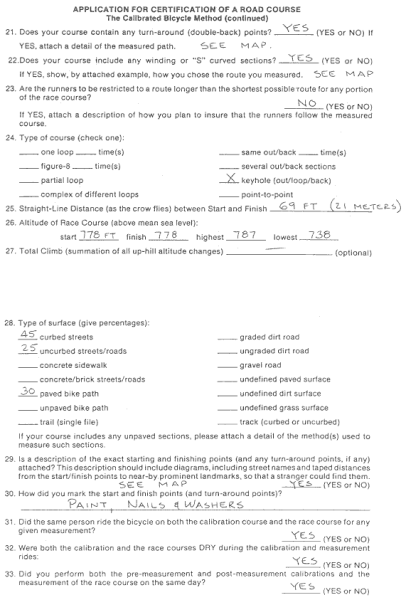
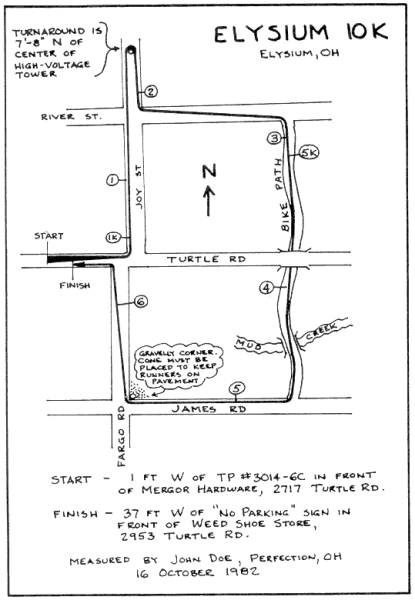
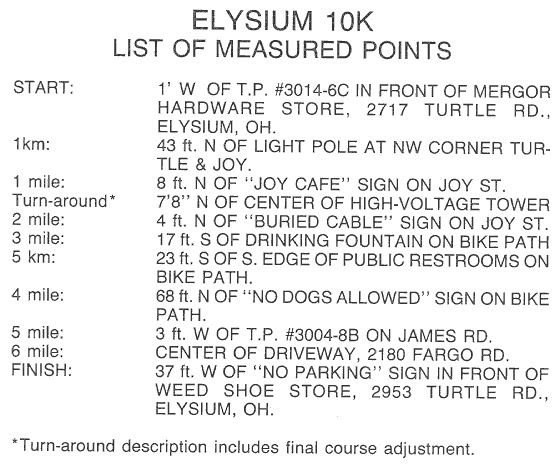
| Go to Next Section: | Appendix C - Example - Course Maps |
| Previous Section: | Appendix C - Example - Calibrating the Bicycle |
| Back to: | Table of Contents |